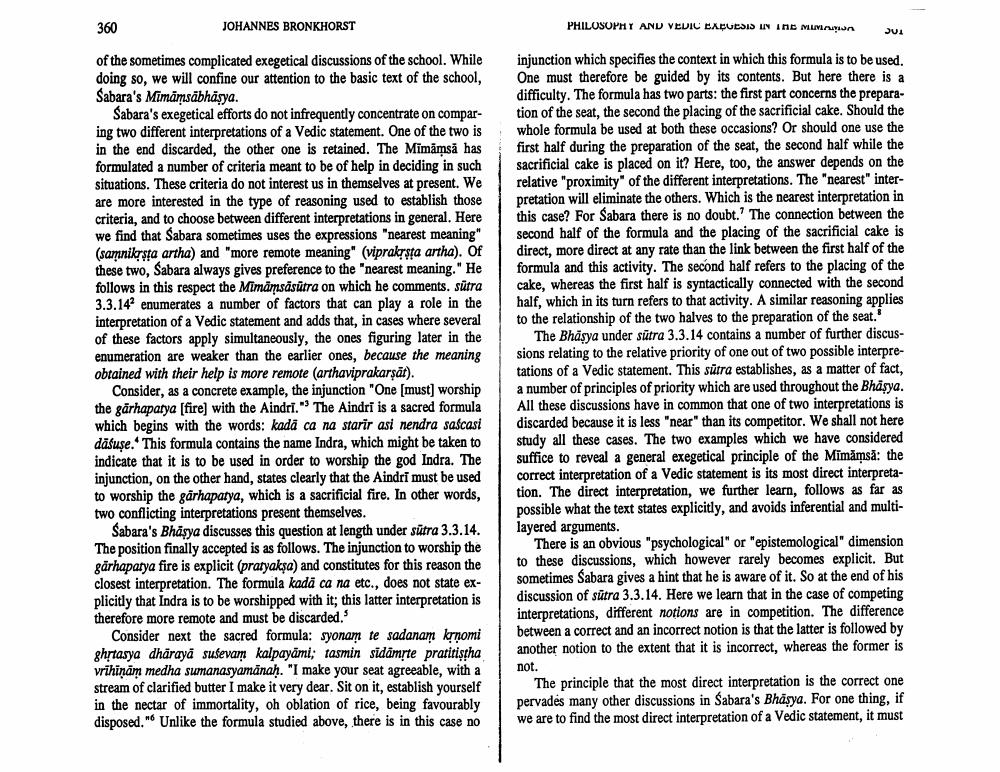Book Title: Philosophy And Vedic Exegesis In Mimamsa Author(s): Johannes Bronkhorst Publisher: Johannes Bronkhorst View full book textPage 2
________________ 360 JOHANNES BRONKHORST PHILOSOPHT AND VEDIC LACUS IN INE MAMA JUA of the sometimes complicated exegetical discussions of the school. While doing so, we will confine our attention to the basic text of the school, Sabara's Mimamsābhäsya. Sabara's exegetical efforts do not infrequently concentrate on comparing two different interpretations of a Vedic statement. One of the two is in the end discarded, the other one is retained. The Mimamsă has formulated a number of criteria meant to be of help in deciding in such situations. These criteria do not interest us in themselves at present. We are more interested in the type of reasoning used to establish those criteria, and to choose between different interpretations in general. Here we find that Sabara sometimes uses the expressions "nearest meaning" (samnikysta artha) and "more remote meaning" (viprakasta artha). Of these two, Sabara always gives preference to the nearest meaning." He follows in this respect the Mimämsäsūtra on which he comments. sutra 3.3.14' enumerates a number of factors that can play a role in the interpretation of a Vedic statement and adds that, in cases where several of these factors apply simultaneously, the ones figuring later in the enumeration are weaker than the earlier ones, because the meaning obtained with their help is more remote (arthaviprakarsāt). Consider, as a concrete example, the injunction "One (must) worship the gärhapatya [fire) with the Aindri." The Aindri is a sacred formula which begins with the words: kada ca na starir asi nendra sascasi dāsuse. This formula contains the name Indra, which might be taken to indicate that it is to be used in order to worship the god Indra. The injunction, on the other hand, states clearly that the Aindri must be used to worship the gärhapatya, which is a sacrificial fire. In other words, two conflicting interpretations present themselves. Sabara's Bhäsya discusses this question at length under sūtra 3.3.14. The position finally accepted is as follows. The injunction to worship the gärhapatya fire is explicit (pratyakşa) and constitutes for this reason the closest interpretation. The formula kadä сa na etc., does not state explicitly that Indra is to be worshipped with it; this latter interpretation is therefore more remote and must be discarded.' Consider next the sacred formula: syonam te sadanam komi ghrtasya dharaya suševam kalpayāmi; tasmin sidāmste pratitistha vrihinäm medha sumanasyamanah. "I make your seat agreeable, with a stream of clarified butter I make it very dear. Sit on it, establish yourself in the nectar of immortality, oh oblation of rice, being favourably disposed." Unlike the formula studied above, there is in this case no injunction which specifies the context in which this formula is to be used. One must therefore be guided by its contents. But here there is a difficulty. The formula has two parts: the first part concerns the preparation of the seat, the second the placing of the sacrificial cake. Should the whole formula be used at both these occasions? Or should one use the first half during the preparation of the seat, the second half while the sacrificial cake is placed on it? Here, too, the answer depends on the relative "proximity" of the different interpretations. The "nearest" interpretation will eliminate the others. Which is the nearest interpretation in this case? For Sabara there is no doubt.' The connection between the second half of the formula and the placing of the sacrificial cake is direct, more direct at any rate than the link between the first half of the formula and this activity. The second half refers to the placing of the cake, whereas the first half is syntactically connected with the second half, which in its turn refers to that activity. A similar reasoning applies to the relationship of the two halves to the preparation of the seat.' The Bhäşya under sūtra 3.3.14 contains a number of further discussions relating to the relative priority of one out of two possible interpretations of a Vedic statement. This sūtra establishes, as a matter of fact, a number of principles of priority which are used throughout the Bháşya. All these discussions have in common that one of two interpretations is discarded because it is less "near than its competitor. We shall not here study all these cases. The two examples which we have considered suffice to reveal a general exegetical principle of the Mīmāmsă: the correct interpretation of a Vedic statement is its most direct interpretation. The direct interpretation, we further learn, follows as far as possible what the text states explicitly, and avoids inferential and multilayered arguments. There is an obvious "psychological" or "epistemological dimension to these discussions, which however rarely becomes explicit. But sometimes Sabara gives a hint that he is aware of it. So at the end of his discussion of sūtra 3.3.14. Here we learn that in the case of competing interpretations, different notions are in competition. The difference between a correct and an incorrect notion is that the latter is followed by another notion to the extent that it is incorrect, whereas the former is not. The principle that the most direct interpretation is the correct one pervades many other discussions in Sabara's Bhäsya. For one thing, if we are to find the most direct interpretation of a Vedic statement, it mustPage Navigation
1 2 3 4 5 6 7
